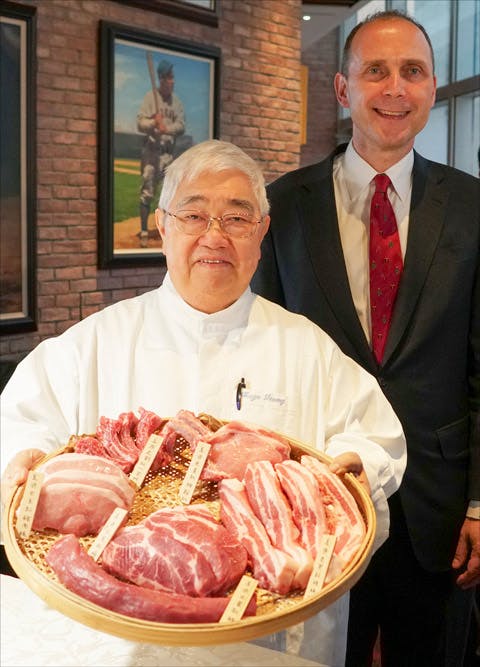U.S. Chilled Pork Supply Chain Represents Great Opportunities in Hong Kong
A decline in Hong Kong’s fresh pork supply due to African swine fever (ASF) is creating both short-term and long-term opportunities for U.S. pork.
At a USMEF press conference announcing plans to fill Hong Kong's growing fresh pork supply gap with U.S. chilled pork, Joel Haggard, USMEF senior vice president for the Asia Pacific, said the opportunity could benefit the U.S. pork industry in both the near and distant future, as more consumers adapt to chilled pork rather than fresh “warm” pork derived from hogs imported from China.

Joel Haggard, USMEF senior vice president for the Asia Pacific, addresses the media during a press conference in Hong Kong to announce implementation of a new U.S. chilled pork supply chain
The press conference, which featured an address by Hanscom Smith, U.S. Consul General to Hong Kong and Macau, received funding support from the National Pork Board.
“Despite neighboring Asian countries like Taiwan and Singapore slowly moving toward a consistent chilled pork supply chain, Hong Kong’s consumers have remained steadfast in their preference for fresh, warm pork and they have been willing to pay a premium for it,” said Haggard, referring to pork sold by Hong Kong’s vast network of wet market vendors. “The current supply situation opens opportunities for increased sales of U.S. chilled pork in the short term and to convince more consumers to accept chilled pork as a permanent alternative.”

Supermarket advertisements promote availability of U.S. chilled pork in Hong Kong
USMEF President and CEO Dan Halstrom explained the benefit of moving more vacuum-packaged U.S. chilled pork into the Hong Kong market, pointing to the success chilled products have achieved in other Asian countries such as Japan and South Korea.
“What chilled product can do that frozen product typically cannot is encourage a 52-week per year program business opportunity,” said Halstrom. “Frozen pork can be stored, and importers can hold onto it. High-quality chilled product is meant to be moved consistently, week in and week out. The goal is to establish a supply chain and continue to grow the chilled pork segment.”
The press conference highlighted establishment of a new U.S. chilled pork supply chain that will make U.S. chilled pork readily available at less cost to consumers than the current prices for fresh pork. Haggard said some U.S. items could be also priced lower than chilled products from competing suppliers like Thailand, Australia and China.
There are challenges to establishing the supply chain – for example, it takes a few more days to ship to Hong Kong than to Japan and Korea – but the U.S. industry is aggressively stepping up to address these issues.
“Wet market vendors in Hong Kong still need to be taught how to handle vacuum-packaged chilled product,” said Haggard. “We are just getting started, and getting product that last mile to the many small outlets in Hong Kong’s meat sales environment is a challenge.”

Haggard was joined at the USMEF press conference by U.S. Consul General Hanscom Smith (left) and chef Hugo Leung (center), U.S. chilled pork ambassador in Hong Kong
Initially, U.S. chilled pork will be sold in major supermarkets, although a few wet market vendors have also initiated U.S. chilled pork sales. Haggard pointed out that one day after USMEF’s press conference, a major supermarket chain in Hong Kong released a series of promotional advertisements for U.S. chilled pork with special pricing.
“So, we are off to the races,” he said. “At this point, chilled U.S. pork can be found in more than 100 supermarket outlets and some wet markets are also handling it. This is greater chilled pork distribution than we’ve ever had in Hong Kong.”

U.S. Consul General Hanscom Smith (right) and chef Hugo Leung pose with a tray of U.S. chilled pork cuts now available in Hong Kong
USMEF and U.S. pork exporters have been exploring the feasibility of establishing a reliable chilled pork supply chain to Hong Kong for decades, Haggard said, noting that the arrival of ASF has created a new opening. Hong Kong historically has imported live hogs from China – roughly 4,000 per day in recent years – and processed them through a city-run slaughter facility. From there, the fresh carcasses are distributed to wet markets, where pork is sold “fresh and warm.”
Due to ASF, the daily number of live hogs brought in from China has fallen below 2,000.
“This has caused a shortage of local fresh pork, and the fresh product still available is being sold a much higher prices,” said Haggard.
At the USMEF Strategic Planning Conference held last month in Tucson, Arizona, Haggard provided anecdotal insights into consumption trends in Hong Kong and some ways the U.S. pork industry can capitalize.
“It’s obvious just visiting businesses in my neighborhood that African swine fever is going to change meat consumption patterns and animal protein consumption patterns throughout all of Asia,” said Haggard, a longtime resident of Hong Kong. “Most people responded by saying they were eating less pork. About 80% of respondents said high prices were the driving factor.”
Referring to his personal experiences in the region, Haggard noted that frozen product is taking the place of fresh meat in the retail sector. He said introducing and promoting U.S. chilled pork is something that USMEF has actively strived for in the past, but the current situation is very favorable for a product launch.
“We’ve been asking ourselves if we can put together a chilled pork supply chain to take the place of fresh pork,” he said. “Can we do it? USMEF is confident we can. We have price on our side and the surveys show that consumers really like our product. The consumer side is going to work, but the supply chain side is what we have to perfect.”
